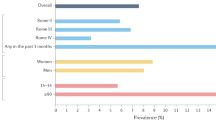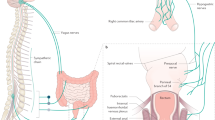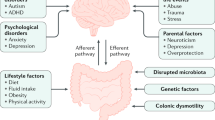Abstract
Fecal incontinence is a common symptom that often impairs quality of life. It is generally caused by a variety of conditions that are associated with anorectal sensorimotor dysfunction and/or diarrhea. Assessment should be tailored to age and symptom severity. Modulation of disordered bowel habits is the key to management; biofeedback and surgery might also be beneficial.
This is a preview of subscription content, access via your institution
Access options
Subscribe to this journal
Receive 12 print issues and online access
We are sorry, but there is no personal subscription option available for your country.
Buy this article
- Purchase on Springer Link
- Instant access to full article PDF
Prices may be subject to local taxes which are calculated during checkout



Similar content being viewed by others
References
Whitehead WE et al. (2001) Treatment options for fecal incontinence. Dis Colon Rectum 44: 131–142
Bharucha A (2003) Fecal incontinence. Gastroenterology 124: 1672–1685
Bharucha AE et al. (2005) Prevalence and burden of fecal incontinence: a population-based study in women. Gastroenterology 129: 42–49
Schiller LR (2002) Fecal incontinence. In Gastrointestinal and liver disease (Eds Feldman M et al.) 164–180 Philadelphia: Saunders
Bharucha AE et al. (2005) Relationship between symptoms and disordered continence mechanisms in women with idiopathic faecal incontinence. Gut 54: 546–555
Sun WM et al. (1992) Utility of a combined test of anorectal manometry, electromyography, and sensation in determining the mechanism of 'idiopathic' faecal incontinence. Gut 33: 807–813
Sultan AH et al. (1993) Anal-sphincter disruption during vaginal delivery. N Engl J Med 329: 1905–1911
Varma A et al. (1999) Obstetric anal sphincter injury: prospective evaluation of incidence. Dis Colon Rectum 42: 1537–1542
Parellada CM et al. (1998) Paradoxical high anal resting pressures in men with idiopathic fecal seepage. Dis Colon Rectum 41: 593–597
Vaizey CJ et al. (1999) Prospective comparison of faecal incontinence grading systems. Gut 44: 77–80
Rockwood TH et al. (1999) Patient and surgeon ranking of the severity of symptoms associated with fecal incontinence: the fecal incontinence severity index. Dis Colon Rectum 42: 1525–1532
Pescatori M et al. (1992) New grading and scoring for anal incontinence. Evaluation of 335 patients. Dis Colon Rectum 35: 482–487
Jorge JM and Wexner SD (1993) Etiology and management of fecal incontinence. Dis Colon Rectum 36: 77–97
Rockwood TH et al. (2000) Fecal incontinence quality of life scale: quality of life instrument for patients with fecal incontinence. Dis Colon Rectum 43: 9–16
American Gastroenterological Association (1999) American Gastroenterological Association Medical Position Statement on Anorectal Testing Techniques. Gastroenterology 116: 732–760
McHugh SM and Diamant NE (1987) Effect of age, gender, and parity on anal canal pressures. Contribution of impaired anal sphincter function to fecal incontinence. Dig Dis Sci 32: 726–736
Bartram CI and Sultan AH (1995) Anal endosonography in faecal incontinence. Gut 37: 4–6
Nielsen MB et al. (1993) Endosonographic evaluation of patients with anal incontinence: findings and influence on surgical management. Am J Roentgenol 160: 771–775
Enck P et al. (1997) How reproducible are measures of the anal sphincter muscle diameter by endoanal ultrasound? Am J Gastroenterol 92: 293–296
Agachan F et al. (1996) Defecography and proctography. Results of 744 patients. Dis Colon Rectum 39: 899–905
Rociu E et al. (1999) Fecal incontinence: endoanal US versus endoanal MR imaging. Radiology 212: 453–458
Briel JW et al. (1999) External anal sphincter atrophy on endoanal magnetic resonance imaging adversely affects continence after sphincteroplasty. Br J Surg 86: 1322–1327
Cheong DM et al. (1995) Electrodiagnostic evaluation of fecal incontinence. Muscle Nerve 18: 612–619
Bharucha AE (2004) Outcome measures for fecal incontinence: anorectal structure and function. Gastroenterology 126 (Suppl 1): S90–S98
Sun WM et al. (1990) Relation between rectal sensation and anal function in normal subjects and patients with faecal incontinence. Gut 31: 1056–1061
Skoog SM and Bharucha AE (2004) Dietary fructose and gastrointestinal symptoms: a review. Am J Gastroenterol 99: 2046–2050
Read M et al. (1982) Effects of loperamide on anal sphincter function in patients complaining of chronic diarrhea with fecal incontinence and urgency. Dig Dis Sci 27: 807–814
Palmer KR et al. (1980) Double-blind cross-over study comparing loperamide, codeine and diphenoxylate in the treatment of chronic diarrhea. Gastroenterology 79: 1272–1275
Sciarretta G et al. (1992) Post-cholecystectomy diarrhea: evidence of bile acid malabsorption assessed by SeHCAT test. Am J Gastroenterol 87: 1852–1854
Santoro GA et al. (2000) Open study of low-dose amitriptyline in the treatment of patients with idiopathic fecal incontinence. Dis Colon Rectum 43: 1676–1681
Locke GR 3rd et al. (2000) American Gastroenterological Association Medical Position Statement: guidelines on constipation. Gastroenterology 119: 1761–1766
Carapeti EA et al. (2000) Randomized controlled trial of topical phenylephrine in the treatment of faecal incontinence. Br J Surg 87: 38–42
Engel BT et al. (1974) Operant conditioning of rectosphincteric responses in the treatment of fecal incontinence. N Engl J Med 290: 646–649
Norton C and Kamm MA (2001) Anal sphincter biofeedback and pelvic floor exercises for faecal incontinence in adults—a systematic review. Aliment Pharmacol Ther 15: 1147–1154
Norton C et al. (2003) Randomized controlled trial of biofeedback for fecal incontinence. Gastroenterology 125: 1320–1329
Cheung O and Wald A (2004) Review article: the management of pelvic floor disorders. Aliment Pharmacol Ther 19: 481–495
Chapman AE et al. (2002) Systematic review of dynamic graciloplasty in the treatment of faecal incontinence. Br J Surg 89: 138–153
Wexner SD et al. (2002) Long-term efficacy of dynamic graciloplasty for fecal incontinence. Dis Colon Rectum 45: 809–818
Penninckx F (2004) Belgian experience with dynamic graciloplasty for faecal incontinence. Br J Surg 91: 872–878
Thornton MJ et al. (2004) Long-term follow-up of dynamic graciloplasty for faecal incontinence. Colorectal Dis 6: 470–476
Wong W et al. (2002) The safety and efficacy of the artificial bowel sphincter for fecal incontinence: results from a multicenter cohort study. Dis Colon Rectum 45: 1139–1153
Mundy L et al. (2004) Systematic review of safety and effectiveness of an artificial bowel sphincter for faecal incontinence. Br J Surg 91: 665–672
Shirran E and Brazzelli M (2000) Absorbent products for the containment of urinary and/or faecal incontinence in adults. The Cochrane Database of Systematic Reviews, Issue 3, Art. no CD001406
Christiansen J and Roed-Petersen K (1993) Clinical assessment of the anal continence plug. Dis Col Rectum 36: 740–742
Mortensen N and Humphreys MS (1991) The anal continence plug: a disposable device for patients with anorectal incontinence. Lancet 338: 295–297
Giamundo P et al. (2002) The procon incontinence device: a new nonsurgical approach to preventing episodes of fecal incontinence. Am J Gastroenterol 97: 2328–2332
Jarrett ME et al. (2004) Systematic review of sacral nerve stimulation for faecal incontinence and constipation. Br J Surg 91: 1559–1569
Vaizey CJ et al. (1999) Effects of short term sacral nerve stimulation on anal and rectal function in patients with anal incontinence. Gut 44: 407–412
Takahashi T et al. (2003) Extended two-year results of radio-frequency energy delivery for the treatment of fecal incontinence (the Secca procedure). Dis Colon Rectum 46: 711–715
Efron JE et al. (2003) Safety and effectiveness of temperature-controlled radio-frequency energy delivery to the anal canal (Secca procedure) for the treatment of fecal incontinence. Dis Colon Rectum 46: 1606–1618
Lightner DJ (2002) Review of the available urethral bulking agents. Curr Opin Urol 12: 333–338
Shafik A (1995) Perianal injection of autologous fat for treatment of sphincteric incontinence. Dis Colon Rectum 38: 583–587
Kumar D et al. (1998) Glutaraldehyde cross-linked collagen in the treatment of faecal incontinence. Br J Surg 85: 978–979
Feretis C et al. (2001) Implantation of microballoons in the management of fecal incontinence. Dis Colon Rectum 44: 1605–1609
Davis K et al. (2003) Preliminary evaluation of an injectable anal sphincter bulking agent (Durasphere) in the management of faecal incontinence. Aliment Pharmacol Ther 18: 237–243
Tjandra JJ et al. (2004) Injectable silicone biomaterial for fecal incontinence caused by internal anal sphincter dysfunction is effective. Dis Colon Rectum 47: 2138–2146
Noseworthy et al. (Eds; 2003) Neurological Therapeutics: Principles and Practice. Vol 2, 2265 London: Taylor & Francis
Acknowledgements
This work was supported in part by US Public Health Service, NIH grants RO1 HD 38666 and HD 41129.
Author information
Authors and Affiliations
Corresponding author
Ethics declarations
Competing interests
The authors declare no competing financial interests.
Rights and permissions
About this article
Cite this article
Andrews, C., Bharucha, A. The etiology, assessment, and treatment of fecal incontinence. Nat Rev Gastroenterol Hepatol 2, 516–525 (2005). https://doi.org/10.1038/ncpgasthep0315
Received:
Accepted:
Issue Date:
DOI: https://doi.org/10.1038/ncpgasthep0315
This article is cited by
-
Pelvic Floor Therapy and Initial Interventions for Pelvic Floor Dysfunction in Gynecologic Malignancies
Current Oncology Reports (2024)
-
Symptoms of anal incontinence and quality of life: a psychometric study of the Norwegian version of the ICIQ-B amongst hospital outpatients
Archives of Public Health (2022)
-
Constipation and Fecal Incontinence in the Elderly
Current Gastroenterology Reports (2020)
-
Epidemiology, Pathophysiology, and Classification of Fecal Incontinence: State of the Science Summary for the National Institute of Diabetes and Digestive and Kidney Diseases (NIDDK) Workshop
American Journal of Gastroenterology (2015)
-
ACG Clinical Guideline: Management of Benign Anorectal Disorders
American Journal of Gastroenterology (2014)



